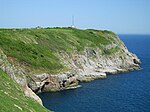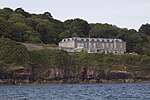SM UB-60
1917 shipsGerman Type UB III submarinesShips built in HamburgU-boats commissioned in 1917World War I submarines of Germany

SM UB-60 was a German Type UB III submarine or U-boat in the German Imperial Navy (German: Kaiserliche Marine) during World War I. She was commissioned into the Training Flotilla of the German Imperial Navy on 6 June 1917 as SM UB-60.She operated as part of the Training Flotilla based in Kiel. UB-60 was surrendered to the Allies at Harwich on 26 November 1918 in accordance with the requirements of the Armistice with Germany. She was sold by the British Admiralty to George Cohen on 3 March 1919 for £1,850, but foundered in tow en-route from Chatham to Swansea for breaking-up on 12 June 1919.
Excerpt from the Wikipedia article SM UB-60 (License: CC BY-SA 3.0, Authors, Images).Geographical coordinates (GPS)
| Latitude | Longitude |
|---|---|
| N 50.322222222222 ° | E -3.4772222222222 ° |








